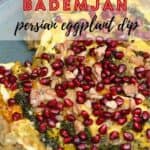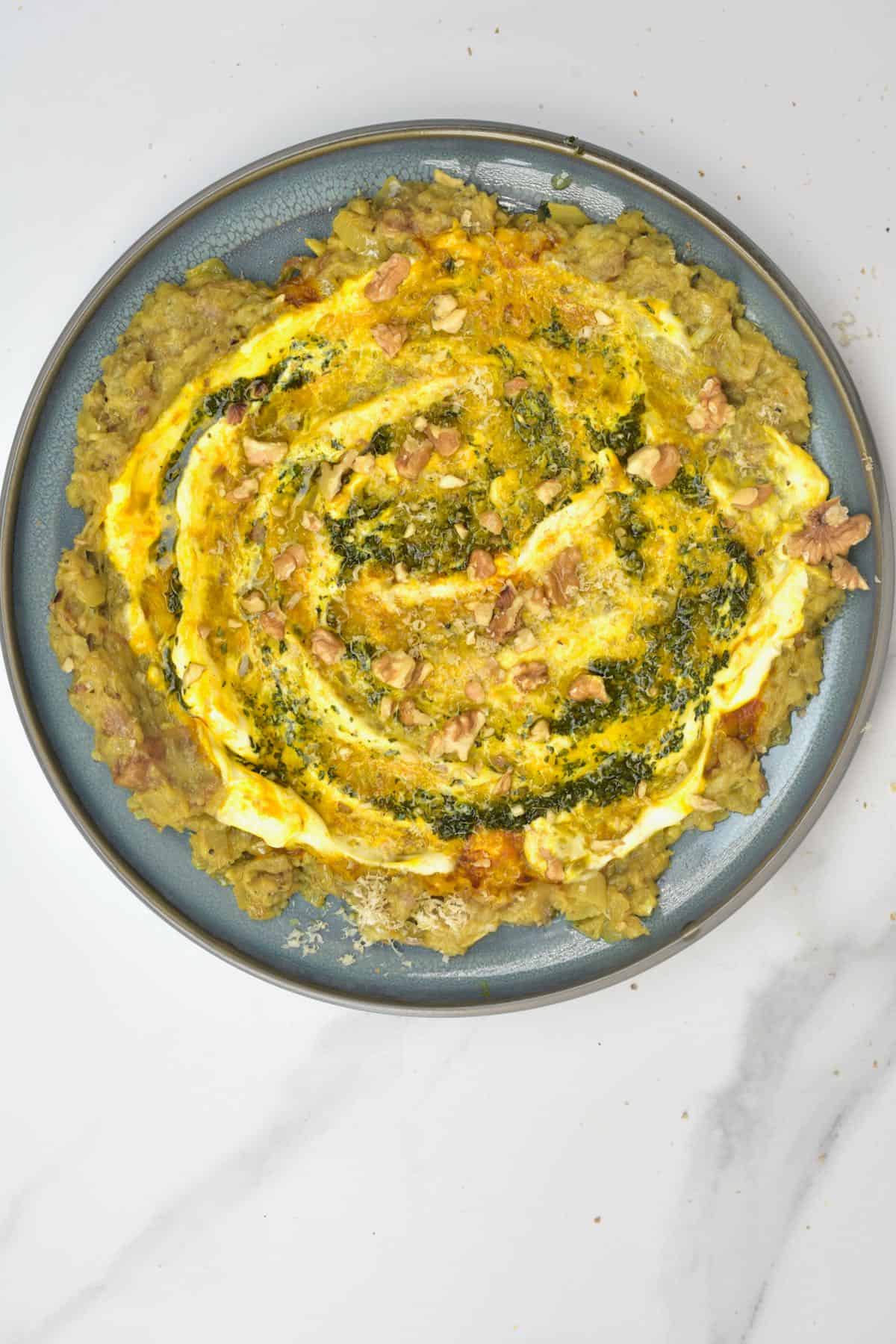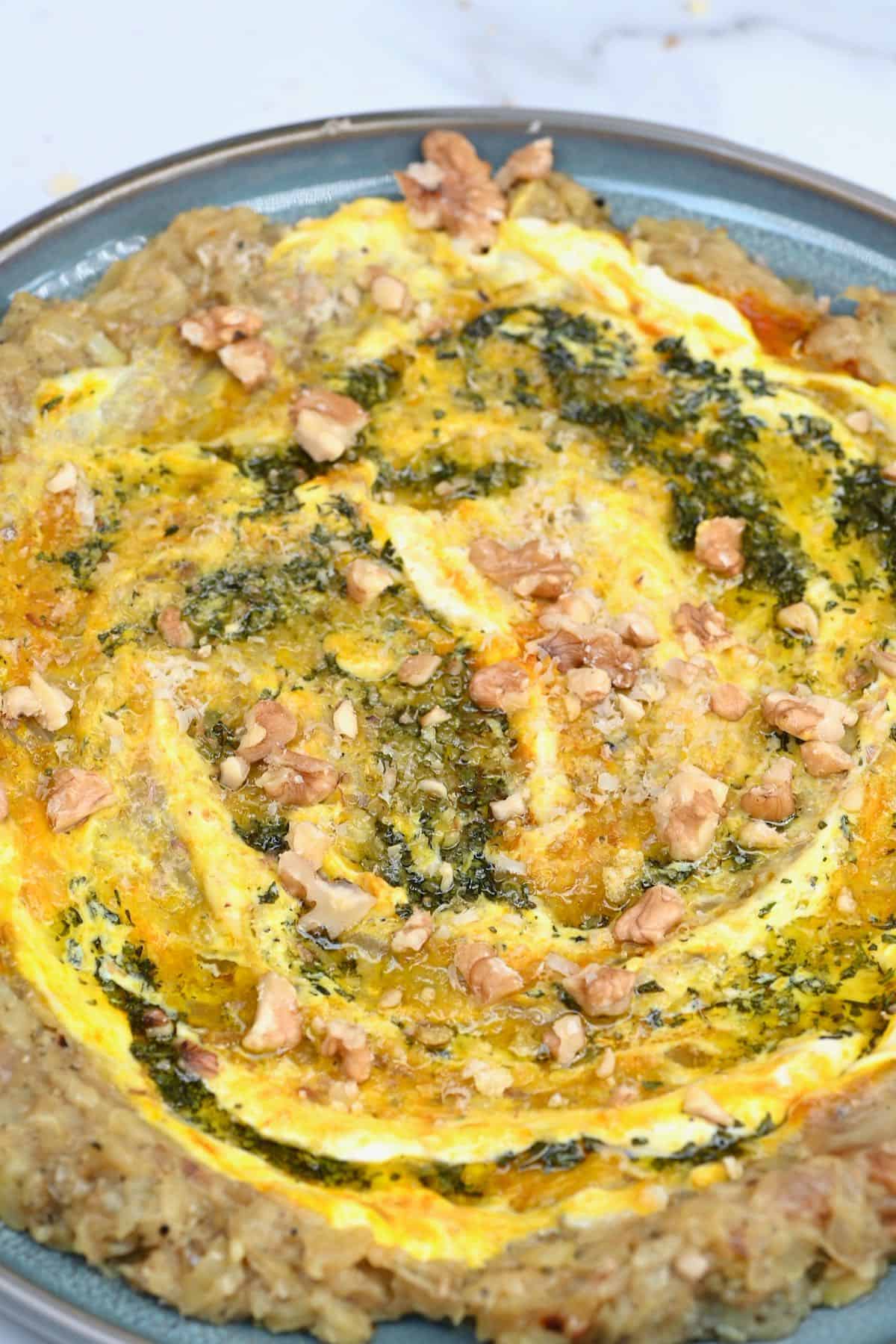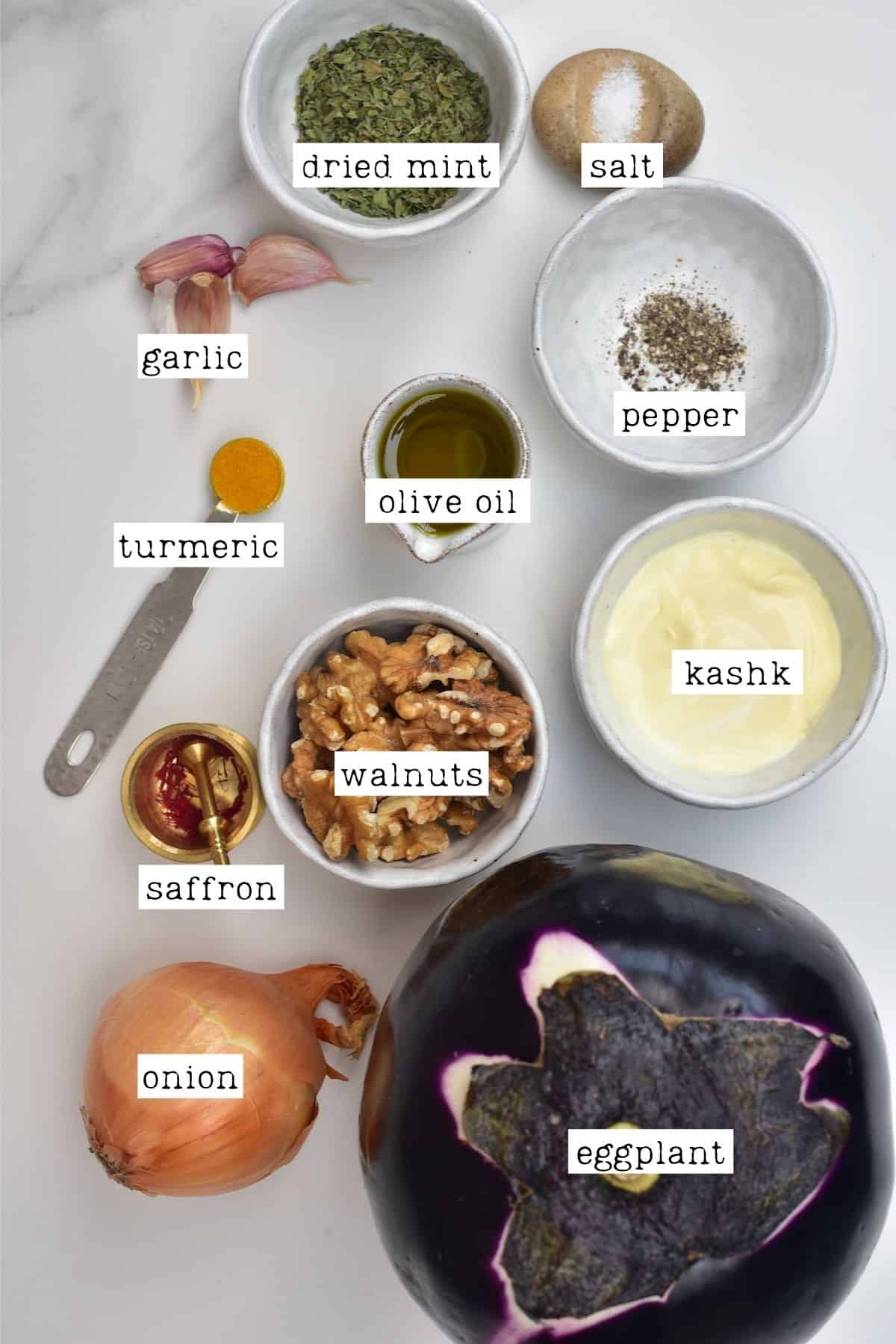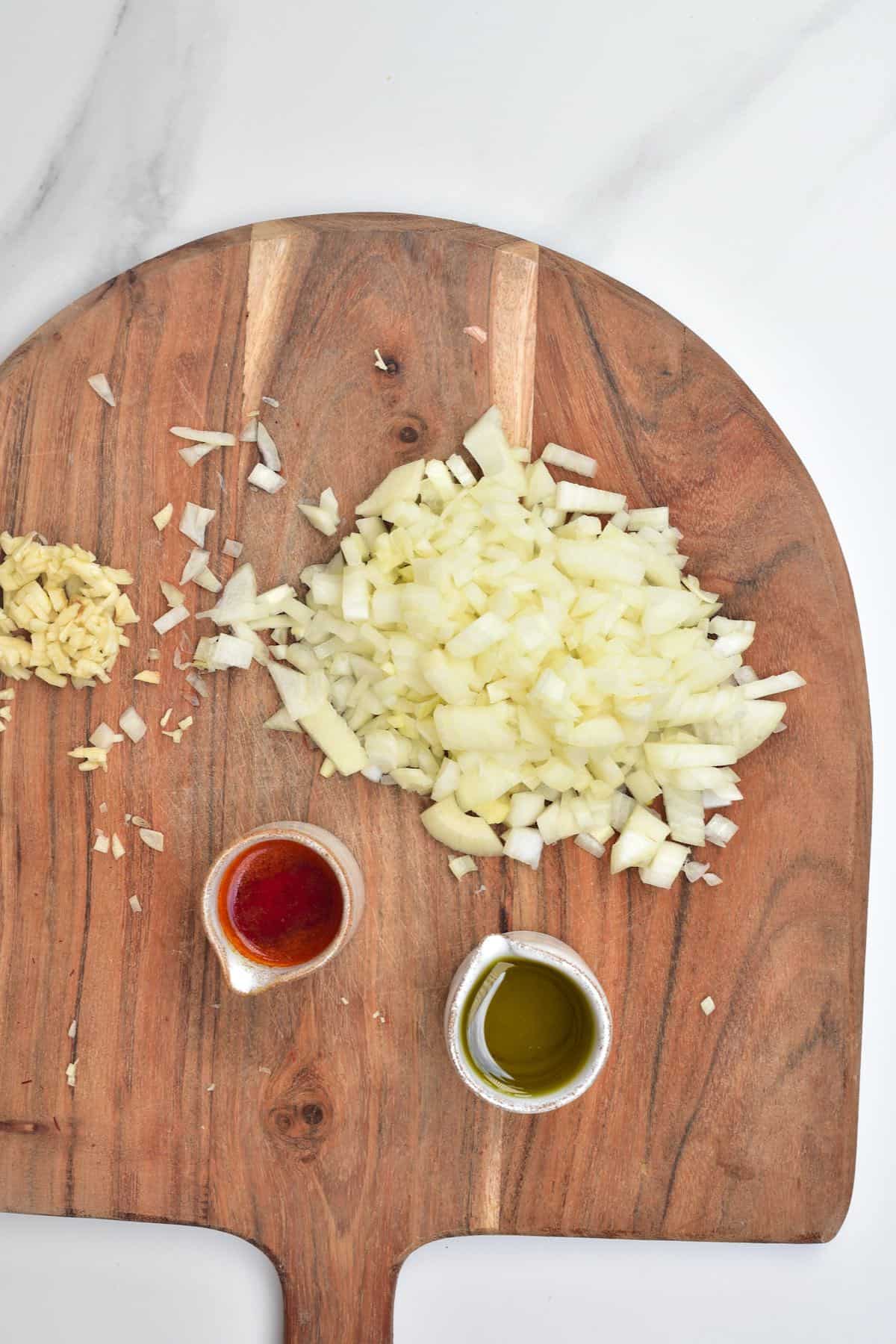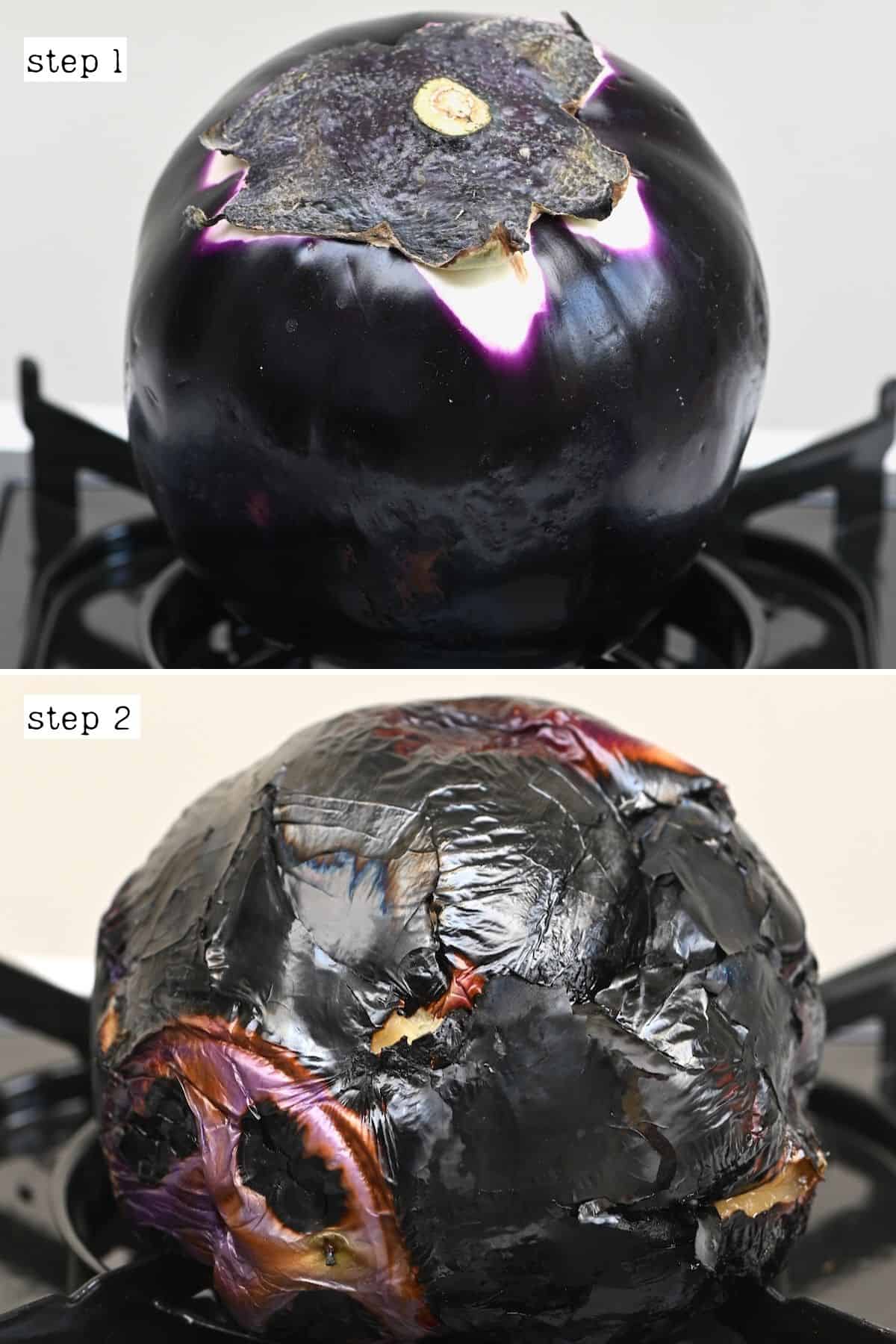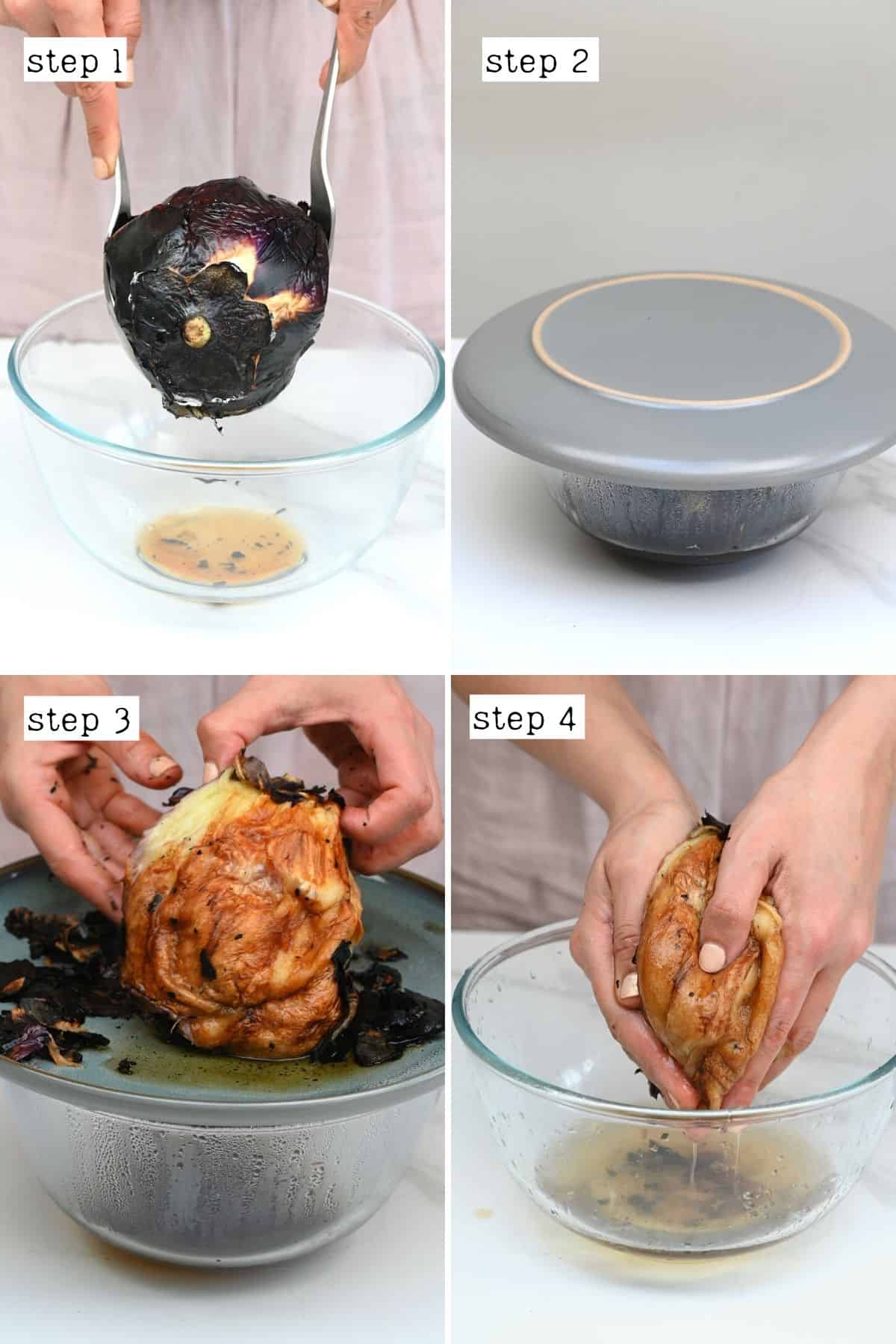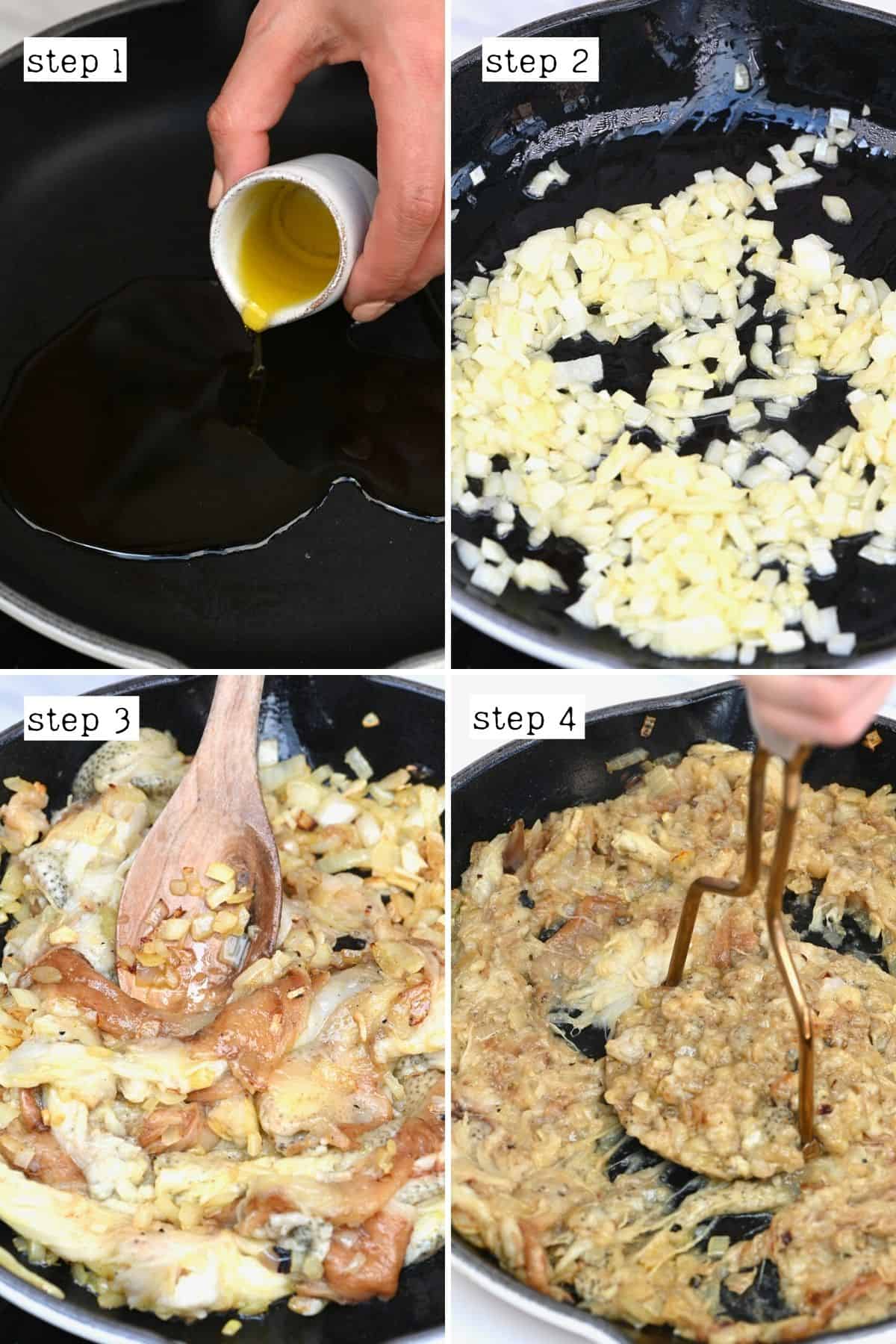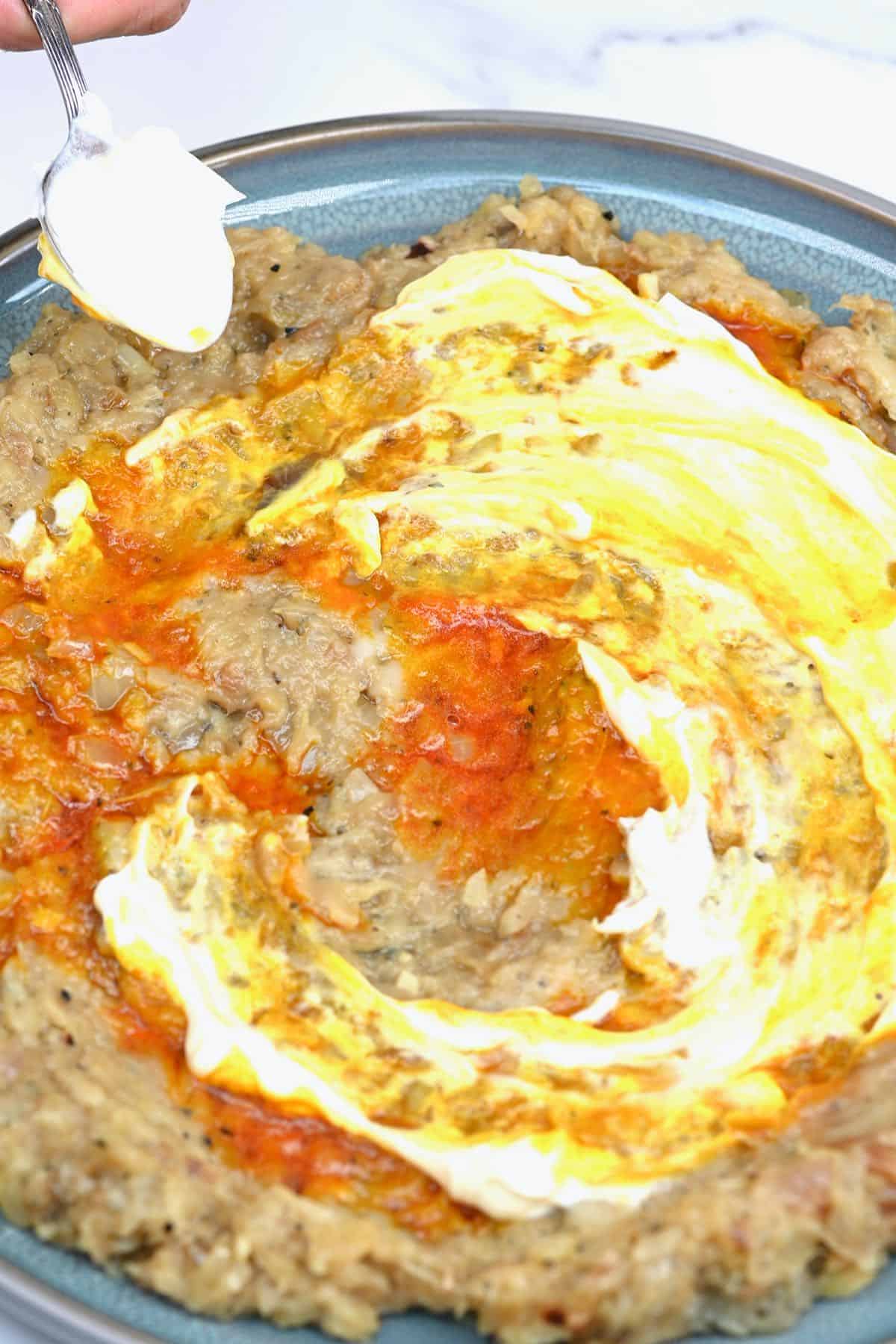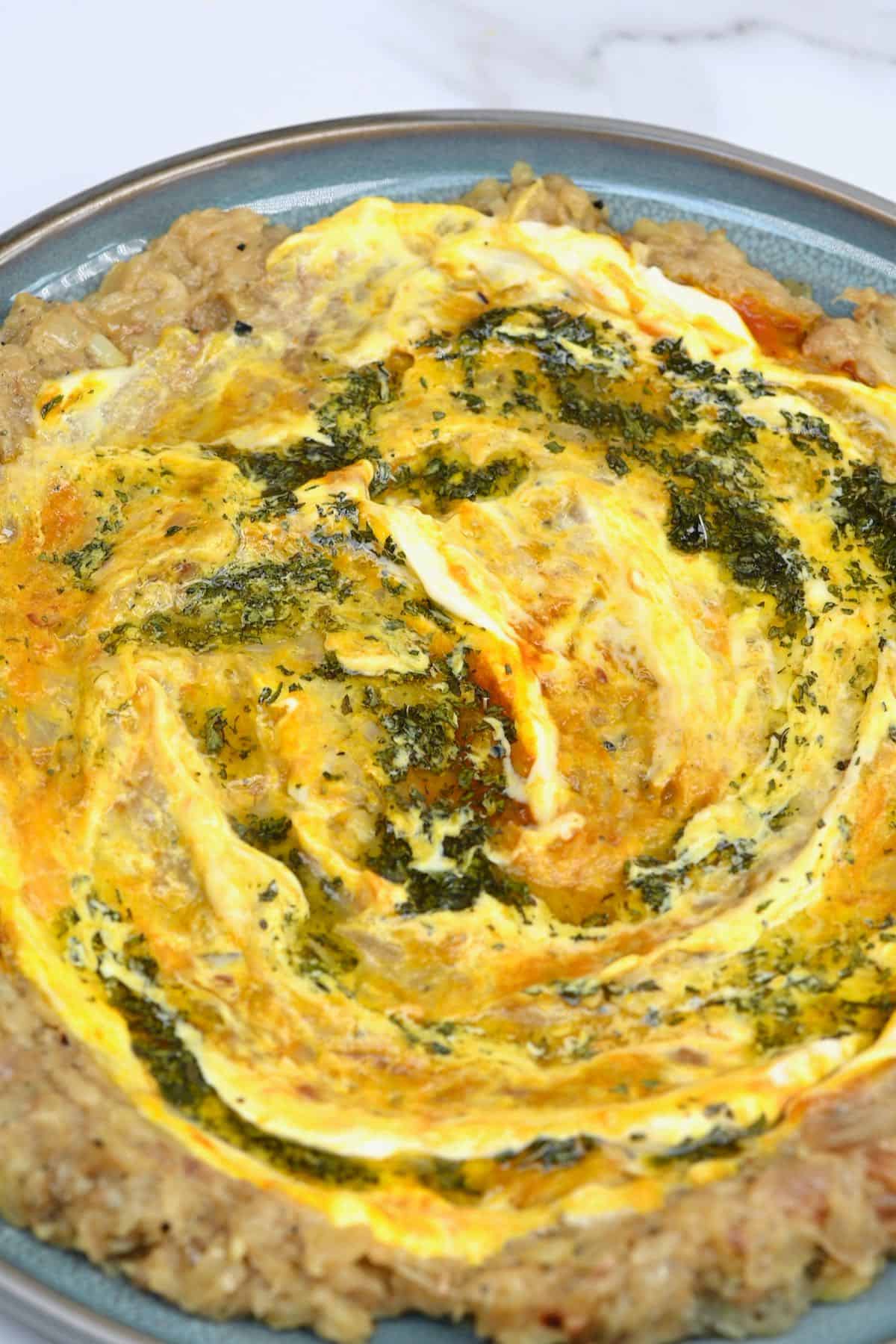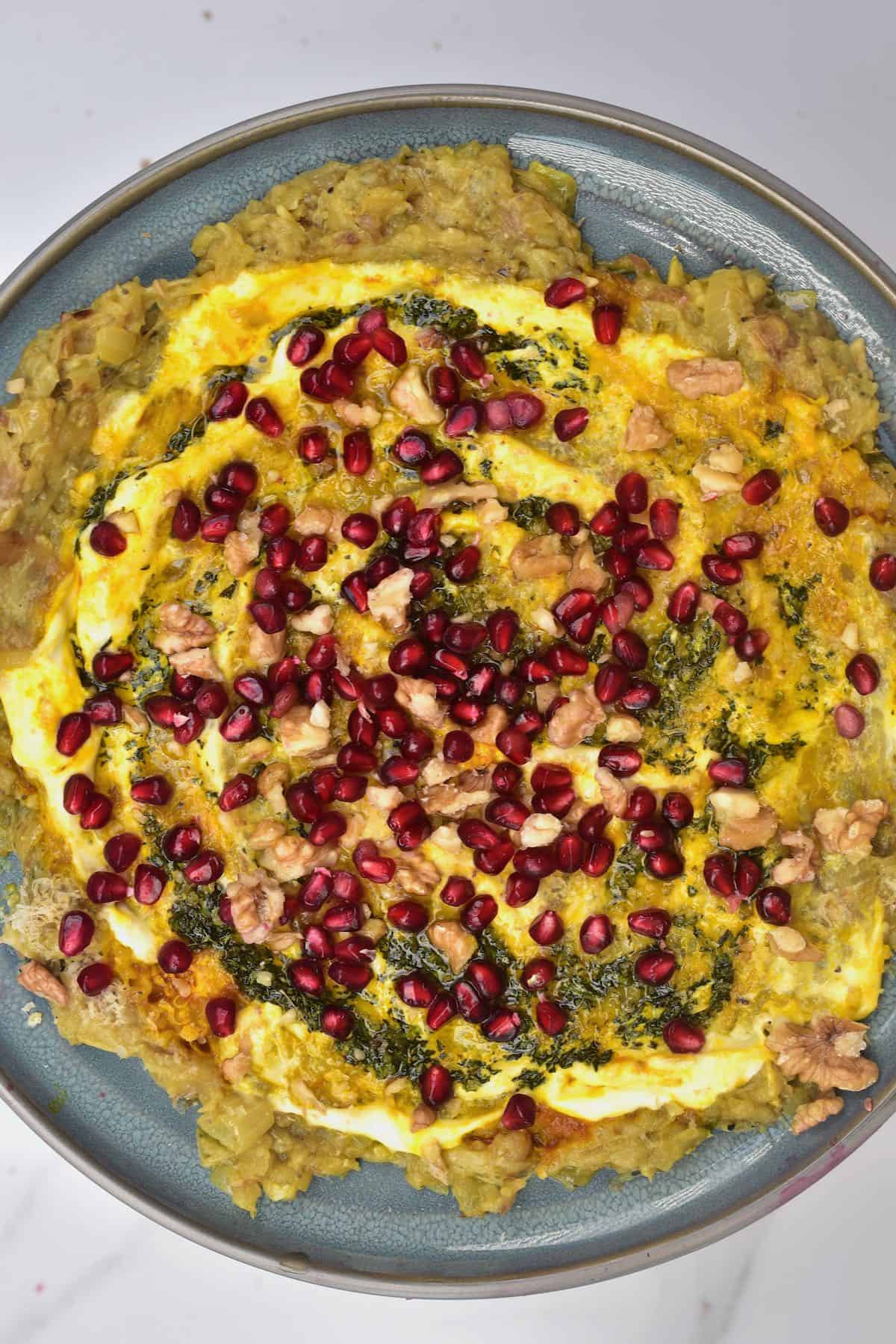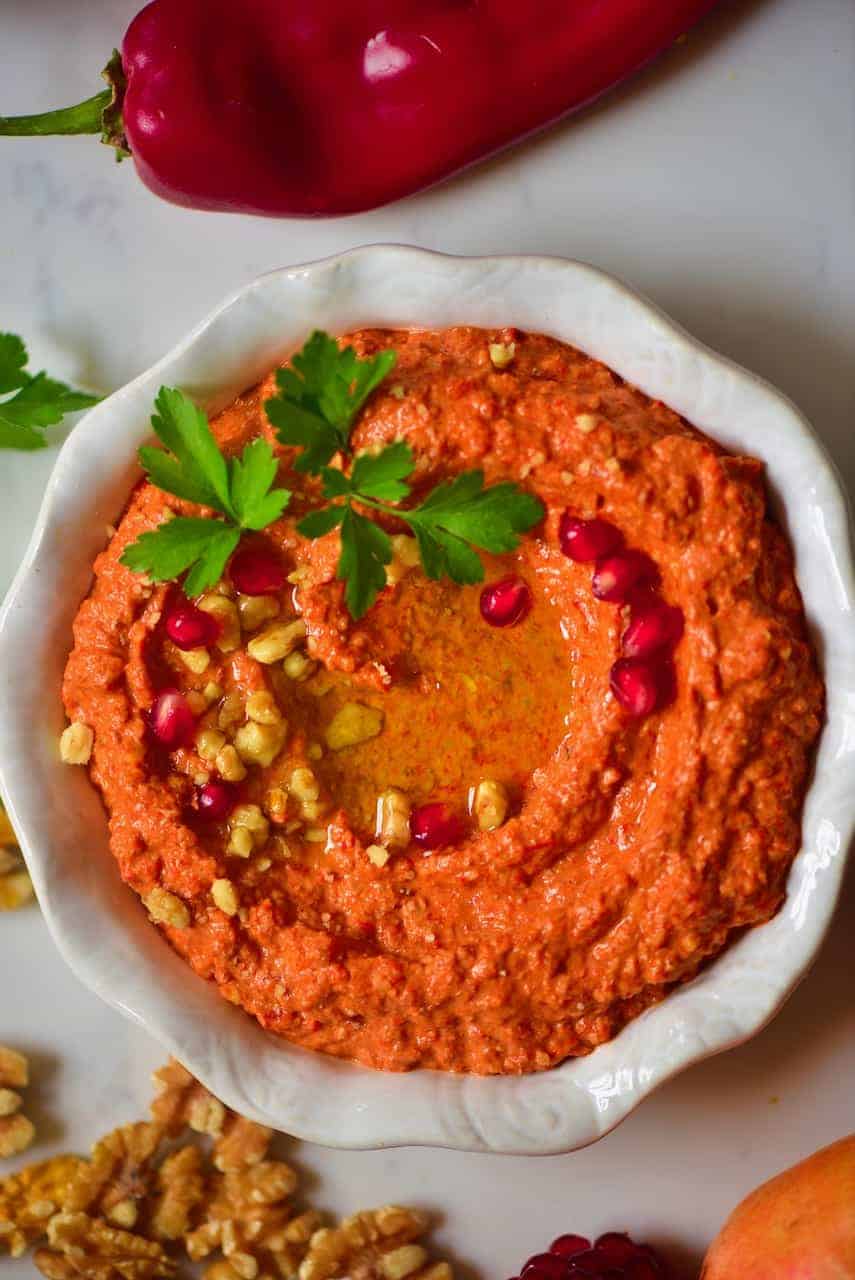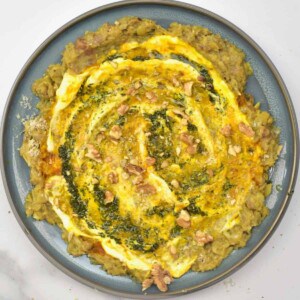I don’t think I’ll ever get sick of eggplant dips, whether smoky like Moutabal – Smoky Eggplant Dip, spicy like Spicy Roasted Eggplant Dip, or creamy and tangy like this kashke bademjan. This dip remains very simple, with just a handful of ingredients (like the others), and is packed with flavor. However, unlike the other dips, this Persian eggplant dip is traditionally served warm and contains a special ingredient! The method is also straightforward. The eggplant is roasted whole (no salting required), then mashed up and added to a skillet with sauteed/caramelized onions and garlic. Combine or top with kashk and additional toppings, including dried mint and lightly toasted walnuts. If you love eggplant as much as I do, this creamy dip is sure to become a new favorite and a great way to use up leftover eggplant. I’ve already shared several other favorite recipes of mine this summer, including a grilled eggplant and halloumi wrap, tomato eggplant pasta (pasta alla norma), and Chinese eggplant stir-fry (with garlic sauce). However, this time I’m stepping away from mains towards a delicious eggplant appetizer!
What is Kashke Bademjan?
Kashke bademjan (sometimes spelled kashk e bademjan or kashko bademjan) is a simple, creamy Persian eggplant dip made with kashk and bademjan (eggplant). Kashk is otherwise called “yogurt whey” (or aarul, shortan, kishk, qurut, etc., depending on the country) and is a fermented yogurt or sour milk product that has been drained and has a tangy, salty flavor. Looking for more eggplant inspiration? You might also like my recipes for miso-glazed eggplant (Nasu Dengaku), healthy Vegetarian Eggplant Salad, crispy Baked Eggplant Fries, or stuffed makdous (cured eggplant)!
The Ingredients
Eggplant: you can use one larger eggplant or several smaller ones. Smaller eggplants (like Chinese eggplants) often contain fewer seeds and will be less bitter and better for this dip. But I’ve used both with good results (as you can see). Kashk: Kashk should be used for the most authentic flavor as it just isn’t the same as yogurt. However, if there’s no kashk available, you can try sour homemade labneh, sour cream, or natural yogurt – with a little additional lemon juice. Aromatics: I used a combination of onion (yellow) and garlic (adjust the amount to personal preference). Seasonings: this simple eggplant dip uses a combination of turmeric (optional), dried mint, saffron (optional), and salt & pepper. Walnuts: used to top the dip, these can be lightly toasted.
How to Make Kashke Bademjan?
Step 1: Chop the aromatics First, finely chop the onion and garlic. At the same time and if using, break the saffron down into a powder and combine it with just a little water for “bloomed saffron.” Step 2: Cook the eggplant While the eggplant is traditionally fried, I prefer to char it over an open flame. However, you could also grill or bake the eggplant. To char over the open flame, cook for a few minutes (4-5) on each side until a skewer passes easily through the eggplant. It may be easier to do this over a heatproof “rack” to cook the eggplant evenly. Alternatively, to roast the eggplant, slice it in half, brush it with a little oil, and then place flesh-side-down on a tray and bake in a preheated oven at 400ºF/200ºC for 50-60 minutes, or until the eggplant begins to collapse and is tender. Check out more tips for How To Cook Eggplant (Baked, Broiled & Air Fryer Eggplant) Step 3: Steam the eggplant Place the eggplant in a bowl/container and cover it with a lid to steam for 10 minutes. Then, peel the skin from the eggplant – it should come off very easily after the steaming. Alternatively, you can scoop the insides out with a spoon. Make sure to gently squeeze the flesh to remove the excess juices (to discard). Step 4: Sauté the ingredients Head up the oil in a large pan. Then add the onion, garlic, and turmeric (optional) and saute for 2-3 minutes, until beginning to become translucent. Then add the charred eggplant, mixing well. I use a potato masher to mash the ingredients directly in the pan until it’s creamy, but you still have the slightly stringy texture of the eggplant (alternatively, you can use a food processor/immersion blender for a smooth consistency if that’s your preference). You could make this easier by mashing the eggplant more before adding it to the pan. Now there are two ways you can go ahead. Some people add the kashk to the pan too. That way, the flavors meld. Alternatively, you can leave the kashk out, for now, mixing it in as a “topping” towards the end. Lightly saute the mixture over medium heat for 5-10 to meld and slightly reduce the leftover liquid in the eggplant. Meanwhile, in a small pan, add a little oil and the dried mint and fry for a few seconds until fragrant. Then remove from the heat. You can also dry-fry the walnuts for 2-3 minutes until fragrant (this can also be done in advance). Step 5: Assemble and serve Transfer the Persian eggplant dip to a large serving bowl. Top with the kashk (or more, if you’ve added it within the dip, too), the saffron liquid (if using), mint, and walnuts – or the toppings of your choice (suggestions in recipe notes). I also like to add pomegranate seeds just before serving – though this isn’t traditional.
How to Store?
Store: store leftovers of the Persian eggplant dip in an airtight container in the fridge for between 2-3 days. Freeze: I haven’t tried freezing kashke bademjan but have done so with similar eggplant dips. To freeze, I recommend doing so before adding the kashk. Allow it to cool completely, then transfer to a freezer-safe container for 2 months. Allow it to thaw before mixing well again, give a taste and adjust any seasonings if needed – then add the kashk and toppings and enjoy! Reheat: reheat the kashk e bademjan either on the stovetop or in the microwave.
How to Serve?
Kashke bademjan is traditionally enjoyed warm/hot or at room temperature rather than chilled (though you can enjoy it chilled too). I love to enjoy it as an appetizer alongside warm bread like no-knead Dutch oven bread, homemade garlic naan, or homemade pita bread. You can also enjoy this dip spread over sandwiches and wraps like Healthy Grilled Eggplant and Halloumi Wrap.
Recipe Notes
For the best texture: make sure to hand-mash the eggplant so it’s still slightly chunky but creamy. You can technically use a food processor/immersion blender, but the texture won’t be traditional. Using kashk for the first time: if you’ve never tried kashk before, it can be a bit of an acquired taste. For that reason, I recommend adding 1 Tbsp at a time to personal preference. For extra mint flavor: you can optionally add extra dried mint to the pan to mix directly into the kashke bademjan. For a nut-free version: feel free to omit the nuts entirely. If you still want the texture, you could use a toasted seed instead, like pine nuts, which also have that “buttery” quality of walnuts.
More Delicious Dip Recipes
If you try this fresh kashke bademjan recipe, I’d love to hear your thoughts/questions below. Also, I’d appreciate a recipe card rating below, and feel free to tag me in your recipe recreations on Instagram @Alphafoodie!
